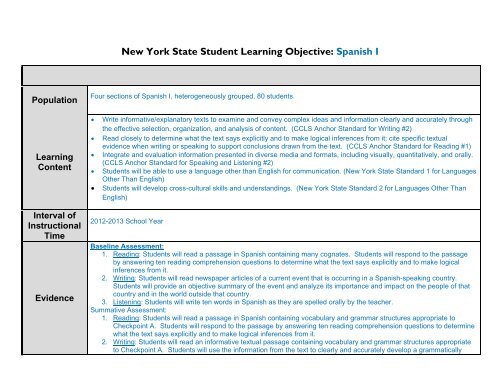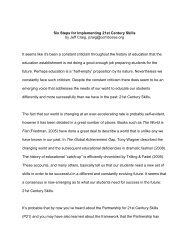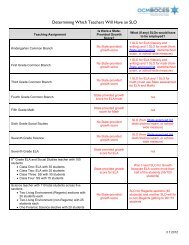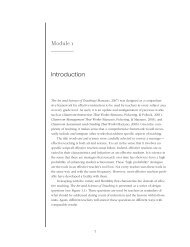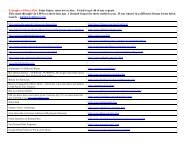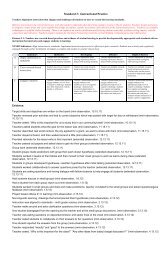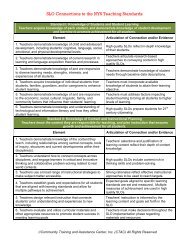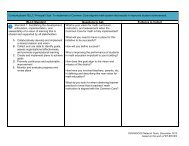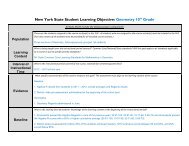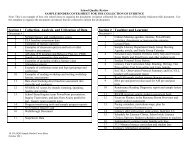New York State Student Learning Objective Template - OCM Boces
New York State Student Learning Objective Template - OCM Boces
New York State Student Learning Objective Template - OCM Boces
Create successful ePaper yourself
Turn your PDF publications into a flip-book with our unique Google optimized e-Paper software.
<strong>New</strong> <strong>York</strong> <strong>State</strong> <strong>Student</strong> <strong>Learning</strong> <strong>Objective</strong>: Spanish I<br />
Population<br />
Four sections of Spanish I, heterogeneously grouped, 80 students.<br />
<strong>Learning</strong><br />
Content<br />
<br />
<br />
<br />
<br />
<br />
Write informative/explanatory texts to examine and convey complex ideas and information clearly and accurately through<br />
the effective selection, organization, and analysis of content. (CCLS Anchor Standard for Writing #2)<br />
Read closely to determine what the text says explicitly and to make logical inferences from it; cite specific textual<br />
evidence when writing or speaking to support conclusions drawn from the text. (CCLS Anchor Standard for Reading #1)<br />
Integrate and evaluation information presented in diverse media and formats, including visually, quantitatively, and orally.<br />
(CCLS Anchor Standard for Speaking and Listening #2)<br />
<strong>Student</strong>s will be able to use a language other than English for communication. (<strong>New</strong> <strong>York</strong> <strong>State</strong> Standard 1 for Languages<br />
Other Than English)<br />
<strong>Student</strong>s will develop cross-cultural skills and understandings. (<strong>New</strong> <strong>York</strong> <strong>State</strong> Standard 2 for Languages Other Than<br />
English)<br />
Interval of<br />
Instructional<br />
Time<br />
Evidence<br />
2012-2013 School Year<br />
Baseline Assessment:<br />
1. Reading: <strong>Student</strong>s will read a passage in Spanish containing many cognates. <strong>Student</strong>s will respond to the passage<br />
by answering ten reading comprehension questions to determine what the text says explicitly and to make logical<br />
inferences from it.<br />
2. Writing: <strong>Student</strong>s will read newspaper articles of a current event that is occurring in a Spanish-speaking country.<br />
<strong>Student</strong>s will provide an objective summary of the event and analyze its importance and impact on the people of that<br />
country and in the world outside that country.<br />
3. Listening: <strong>Student</strong>s will write ten words in Spanish as they are spelled orally by the teacher.<br />
Summative Assessment:<br />
1. Reading: <strong>Student</strong>s will read a passage in Spanish containing vocabulary and grammar structures appropriate to<br />
Checkpoint A. <strong>Student</strong>s will respond to the passage by answering ten reading comprehension questions to determine<br />
what the text says explicitly and to make logical inferences from it.<br />
2. Writing: <strong>Student</strong>s will read an informative textual passage containing vocabulary and grammar structures appropriate<br />
to Checkpoint A. <strong>Student</strong>s will use the information from the text to clearly and accurately develop a grammatically
Baseline<br />
Target(s)<br />
correct summary of the passage.<br />
3. Listening: <strong>Student</strong>s will use Spanish to communicate by answering fifteen listening comprehension questions pertinent<br />
to passages presented orally by the teacher.<br />
4. Final Exam: <strong>Student</strong>s will demonstrate their ability to communicate using Spanish by completing the final exam that<br />
replaces the NYS Second Language Proficiency Exam. <strong>Student</strong>s will be required to have conversations in Spanish<br />
with the teacher, respond to listening comprehension and reading comprehension questions, and to develop two<br />
Checkpoint A appropriate written responses that are clear and accurate to the task provided.<br />
Reading:<br />
65% of students correctly answered 8-10 of the reading comprehension questions.<br />
20% of students correctly answered 5-7 of the reading comprehension questions.<br />
10% of students correctly answered 3-4 of the reading comprehension questions.<br />
5% of students answered 0-2 of the reading comprehension questions.<br />
Writing:<br />
Using an adapted form of the Checkpoint A rubric for writing (see attached),<br />
70% of students scored 14-16 points.<br />
15% of students scored 11-13 points.<br />
7% of students scored 8-10 points.<br />
4% of students scored 5-7 points.<br />
4% of students scored 2-4 points.<br />
0% of students scored 0-1 points.<br />
Listening:<br />
45% of students correctly spelled 8-10 of the words spelled orally by the teacher.<br />
30% of students correctly spelled 5-7 of the words spelled orally by the teacher.<br />
20% of students correctly spelled 3-4 of the words spelled orally by the teacher.<br />
5% of students correctly spelled 0-2 of the words spelled orally by the teacher.<br />
80% of students will score 35 points or higher on the summative assessment pieces (out of a possible 41 points).<br />
OR<br />
80% of students will score 85% or above on the final exam that replaces the NYS Second Language Proficiency exam.<br />
HEDI Scoring<br />
See ranges as specified<br />
HIGHLY<br />
EFFECTIVE<br />
EFFECTIVE DEVELOPING INEFFECTIVE<br />
20 19 18 17 16 15 14 13 12 11 10 9 8 7 6 5 4 3 2 1 0
Rationale<br />
98-<br />
100<br />
%<br />
95-<br />
97%<br />
92-<br />
94%<br />
89-<br />
91%<br />
86-<br />
88%<br />
83-<br />
85%<br />
80-<br />
82%<br />
76-<br />
79%<br />
73-<br />
75%<br />
69-<br />
72%<br />
66-<br />
68%<br />
The <strong>Learning</strong> Content reflects both CCLS anchor standards as well as the NYS standards for Languages Other Than English.<br />
The baseline evidence combines aspects of reading, writing and listening which are three of the four essential skills for<br />
communication in another language. The baseline evidence reflects a greater dependency on, and use of, English to<br />
demonstrate abilities more relative to the CCLS anchor standards for reading, writing and listening. The summative evidence<br />
reflects the use of Spanish in performing these tasks to reflect more of the NYS standards for Languages Other Than English.<br />
In addition, the summative evidence would help to support the CCLS shifts in mathematics; most specifically Shift 4 – Deep<br />
Understanding and Shift 6 – Dual Intensity. To maintain consistency with the former NYS proficiency exam in Spanish,<br />
rubrics for writing (attached) are the ones used in scoring of the proficiency exam.<br />
63-<br />
65%<br />
59-<br />
62%<br />
55-<br />
58%<br />
52-<br />
54%<br />
50-<br />
51%<br />
47-<br />
49%<br />
45-<br />
46%<br />
40-<br />
44%<br />
30-<br />
39%<br />


